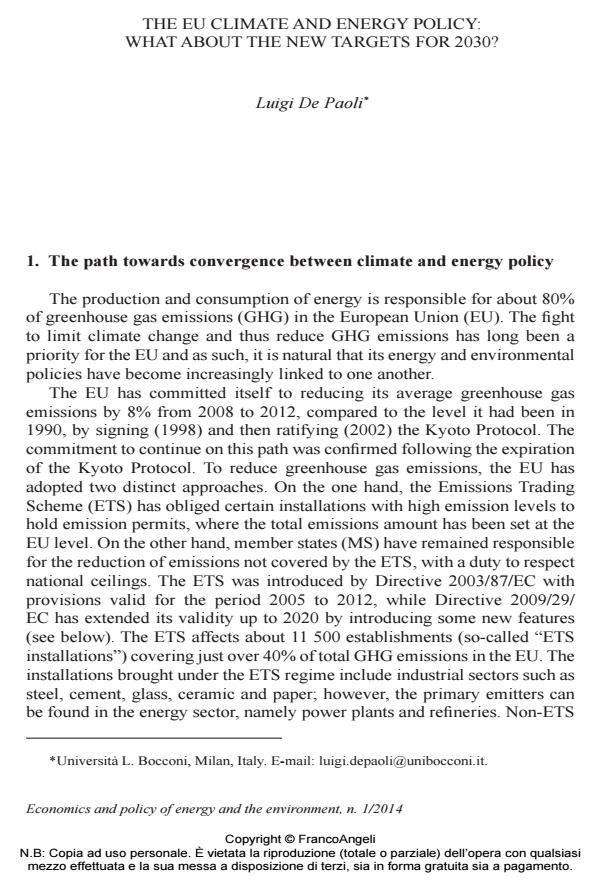The EU climate and energy policy: what about the new targets for 2030?
Journal title ECONOMICS AND POLICY OF ENERGY AND THE ENVIRONMENT
Author/s Luigi De Paoli
Publishing Year 2014 Issue 2014/1
Language English Pages 25 P. 27-51 File size 234 KB
DOI 10.3280/EFE2014-001002
DOI is like a bar code for intellectual property: to have more infomation
click here
Below, you can see the article first page
If you want to buy this article in PDF format, you can do it, following the instructions to buy download credits

FrancoAngeli is member of Publishers International Linking Association, Inc (PILA), a not-for-profit association which run the CrossRef service enabling links to and from online scholarly content.
The EU climate and energy policy for 2020 is summed up by three goals called 20-20-20: a) reduce GHG emissions by 20% compared to 1990; b) save 20% of the EU’s energy consumption compared to projections for 2020; c) develop a 20% share of renewable energies in overall EU energy consumption by 2020. In 2013 the EU Commission issued a Green paper to launch a debate on what should be the objectives for 2030 and early 2014 has published its proposals. This article shares the priority given in the Commission’s communication of January 2014 to the objective of reducing greenhouse gas emissions and argues that this should be the only target set in quantitative terms. Instead, the proposal of continuing to make use of the EU-ETS, although reformed with the introduction of a reserve stability fund, is not shared. In place of this solution, it is suggested to introduce a carbon tax, to be revised (and raised) periodically, based on the reduction of GHG emissions. Its level should be such that the coal power plants without CCS become no longer competitive in a few years. A less preferable solution would be to maintain the cap-and-trade with a floor and ceiling price. The promotion of renewables certainly deserves to be continued, but without quantitative mandatory targets that are not required neither at the European level nor at the level of individual Member States. Moreover, the RES support has to avoid distorting the internal market for electricity. Instead, a common European system of promotion of renewable should be introduced, with clear and limited objectives. Finally, the increase in energy efficiency should also continue to be promoted, but without any quantitative target that would be very difficult to establish and monitor.
Keywords: European energy policy, climate policy, EU ETS, renewable energy, energy efficiency
Jel codes: Q48, Q28, Q54, Q58, H23
- Energy, transport, pollution and natural resources: Key elements in ecological taxation Elena Villar-Rubio, María Dolores Huete Morales, in ECONOMICS AND POLICY OF ENERGY AND THE ENVIRONMENT 1/2017 pp.111
DOI: 10.3280/EFE2016-001006
Luigi De Paoli, The EU climate and energy policy: what about the new targets for 2030? in "ECONOMICS AND POLICY OF ENERGY AND THE ENVIRONMENT" 1/2014, pp 27-51, DOI: 10.3280/EFE2014-001002